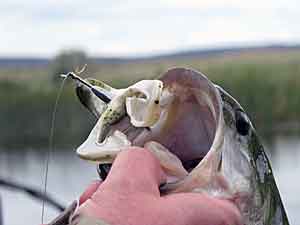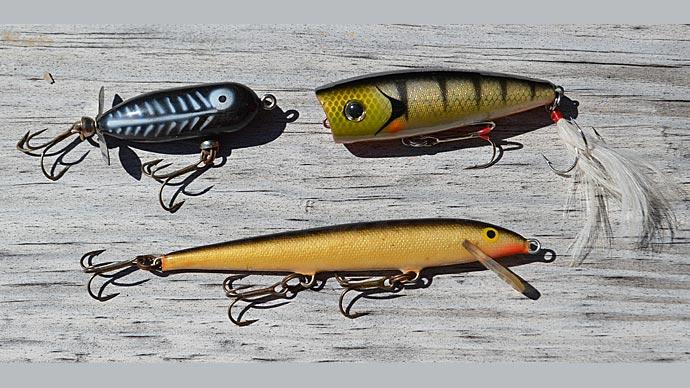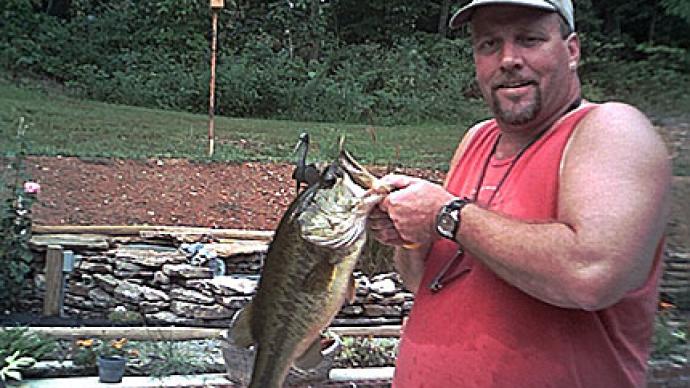
Many of us have tried them, and chances are those who didn't catch much fish with them haven't touched them since! But, of course, I'm talking about those big hollow soft rubber-bodied top waters that we know as Scum Frogs and Snagproof Frogs (or similar baits). There are two main reasons why these baits often make a quick trip back to the bottom of the tackle box. One, you're not getting too many bites, and two, you're missing too many fish or a combination of both. So let's take a closer look at these problems, and I will outline some ways to get around them.
You've taken ten casts, and now you're ready to change baits again. Chances are you're just working that frog a little too fast. If you're fishing the right stuff (thick weed beds or lily pads), you need to slow down your retrieve.
Many guys like to skip the frog along as if it were in a frantic run to get away from a predator. Now logically, that is the correct approach. But, wrong! While you may get "some" bites doing this, you will miss out on the better quality fish by retrieving the bait quickly like this.
Simply put, big bass are big lazy couch potatoes. They will sometimes be in a chasing mood, but most of the time, if they are hiding in the green stuff, they often aren't very active. Instead, they sit around waiting for a nice easy meal to munch on. They also hide to ambush prey, but the bigger fish won't likely chase down a quick-moving bait. Instead, it will just zoom over their head, and they will sit and wonder what all that commotion was.
I like to pop or twitch the bait once or twice, then stop for a few seconds and repeat. Then, when my bait comes to a pocket, weed edge, lily pad, or something else different to key on, I will let it sit, and sit, and then sit some more! I will often let that frog sit there for as long as 15-30 seconds and sometimes up to a minute. Trust me. It is well worth the wait!
Here is the critical part: I will barely twitch it without moving the bait much if there hasn't been a blow-up by now. Naturally, this will make the legs quiver a little, and most often, this is where I will get a big strike.
What you need to realize here is that when retrieving these lures, if there is a fish in the area, he has to have time to hear or see the bait, then swim over to the source of the commotion, then inspect it some more, and then decide whether or not to hit it. Big fish can be very fussy that way.
If that frog seems too quick for him to chase down, he will often they will turn his head in search of an easier meal. They prefer weak or injured food, not marathon runners! These fish "know" that they might be able to catch this thing, but at the same time could probably sit and wait for one that is slow or injured and spend a 10th the energy for the same rewards. They are very smart and conservative like that. They don't grow that large by being stupid and inefficient hunters.
So, in summary, here is a simple formula to help you improve your strike percentage with frogs: FISHING FROGS SLOW=BIG FISH! This principle can be applied to frogs and many other baits, such as jigs and plastic worms.
Ok, now you just had a huge boil, set the hook, and the lure floats back up. What happened? Well, it could be a couple of things. You could be using the wrong equipment or not setting the hook correctly.
The equipment you use (except for the line) is probably less of a factor than how you set the hook. But I will still outline what you should use because it is essential. There are three things your equipment must have for this technique. You must have a beefy rod, a reel with positive anti-reverse, and, most important, braided line. These all play a crucial role in hooking more fish when using frogs.
I prefer to use a 7 to 7 ½ foot medium/heavy- to heavy-action casting rod with an extra-fast tip spooled with 30- to 50-pound Seaguar TactX. You'll need the heavy equipment to horse fish out of cover, and most importantly, it will need to set that hook properly. Many guys prefer to use a flipping stick, which is fine. Use whatever is comfortable for you. Just make sure you have a rod that packs quite a punch.
Sometimes, when fishing lighter cover or tough conditions, I will scale down to a 7- to 7 ½-foot medium/heavy-action spinning rod spooled with 15-pound Seaguar TactX. You may not have as much power to horse the fish out, but you still get that instant hook-up because of the no-stretch property of TactX. You also won't spook as many fish with the smaller diameter line.
Now let's look at why I use braided line. I only use this stuff, not just for its incredible strength. It is nice to have it when fishing that heavy cover. But the most critical factor is the near 0% stretch properties. You don't want to give that fish an inch when setting the hook. When you set the hook, you must depress the frog's cavity to expose the hooks before you can bury the hooks properly. If there is any stretch in your line, the bait can slip out of the fish's mouth long before those hooks become exposed. With Mono, the line will stretch, giving that fish an extra half-second to feel you. And believe it or not, that is often more than enough time for him to open his mouth and let go.
Another reason you may be losing fish is because of "how" you're setting the hook. You could be jerking too early, too late, or with the wrong technique. For example, when a fish blows up on a frog, half the time, he won't even have it in his mouth. Many times all he does is smack the frog under the surface of the water, where he will then attack it once he thinks he has "stunned" his prey. Trust me. I have seen slow-motion photography that illustrates this exceptionally well. So if you set on this, often you will miss him.
As soon as you get the strike, drop your rod immediately, but don't set the hook. If he has it, he won't feel you and spit out the bait. Instead, reel down slowly until the line is semi-slack, waiting and watching for line movement or when you can "feel" the fish. Don't wait too long to set the hook, though. Set as soon as you feel him, or see any line movement.
Set the hook with a swift, hard wrist snap in the opposite direction your line is moving. That could be slightly left, right, back, or even straight up, depending on where the fish hit or the direction he is going.
Before you snap your wrist on the hook set, having some slack in the line is critical. If you try to set on taught line, you will only pull the bait out of the fish's mouth. If you have slack in the line and then set the hook, you will be at maximum velocity in your set when the line tightens up. This will cause the hooks to expose more easily and quickly. This will also pack a heavier punch in the hook set. Think about a boxer. Would he do more damage in one punch if he tried hitting his opponent by starting 3 inches from his face or if he reached way back and drilled him with a right hook? The answer is obvious. The same principle applies when setting the hook in this situation.
The above tips were taught to me a while back when I was one of those anglers who would throw a frog for ten casts and then put it away. Now I ALWAYS have one tied on, and it's become one of my Go-To baits. And if given the time and patience, it could also become a standard on your rod. Good Times and Tight Lines!
BassResource may receive a portion of revenues if you make a purchase using a link above.




